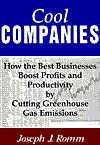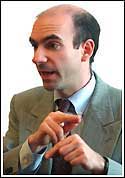
Cool Companies
by Joseph J. Romm
Island Press,
1999, 277 pages
Joseph Romm is director of the nonprofit Center for Energy and Climate Solutions, which helps businesses reduce their greenhouse gas emissions. In 1997, he served as assistant secretary of energy efficiency and renewable energy at the Energy Department.
Romm’s new book, Cool Companies: How the Best Businesses Boost Profits and Productivity by Cutting Greenhouse Gas Emissions, presents a wealth of case studies on businesses that have made great strides in improving their energy efficiency and reducing their emissions of greenhouse gases, businesses that Romm calls “cool companies.” The book also lays out a blueprint for companies that want to make similar changes and expounds on the benefits that they can expect to see, from dramatically lower energy costs to improved employee morale.
(If Cool Companies sounds like your kind of book, you’ll also want to check out Turning Off the Heat by Thomas R. Casten.)
Grist: What would you recommend as a first step for a company looking to go “cool”?

Rappin’ with Joe Cool.
Romm: A company should have a comprehensive energy audit performed by a recognized energy service company. A big company might want to start with just one building or factory. An increasing number of local utilities recommend energy service companies. Small to medium-sized manufacturers can often get a free audit from a local Industrial Assessment Center, which is funded by the Department of Energy (1.800.DOE.EREC). Companies can also contact my organization, the Center for Energy and Climate Solutions, at coolcompan@aol.com for recommendations on where to start.
Grist: What options are available to small businesses that rent office or retail space rather than own their own buildings?
Romm: There are two main options. First, a small business might talk to the building owner about the possibility of jointly investing in efficient equipment and splitting the savings. Second, when the lease is up, the small business should make sure to bring up the issue of energy efficiency in any new lease negotiations.
Grist: Is there a point beyond which investment in energy efficiency stops paying off?
Romm: Lee Eng Lock, the founder of Supersymmetry, an energy service company specializing in clean rooms for the manufacture of computer chips, says, “Efficiency is free. Ask for more.” For large companies, the savings really never end, as numerous case studies in my book make clear, such as those on Dow Chemical and 3M. But even small businesses can find ongoing opportunities for large savings. Moreover, a company that takes a comprehensive and systematic approach to efficiency may find unexpected savings, including improvements in employee productivity and reductions in absenteeism. That’s why I call them “cool companies.” Investment in efficiency won’t stop paying off until a company stops looking for ways to save energy.
Grist: Are most businesspeople surprised by the case studies you present?
Romm: Many businesses are very surprised that there are so many untapped profitable opportunities for saving energy. Energy has not been a focus for most companies for almost two decades. Many of them have downsized or eliminated their corporate energy management function.
Grist: What people within a business tend to be most receptive to your message? Which ones tend to be most resistant?
Romm: The most receptive businesspeople are those in the company who want to cut emissions, especially those in the environment, safety, and health divisions, and those who want to cut costs, such as chief financial officers. The least receptive people are those who perceive that any recognition by the company that there is inefficiency implies that they have been doing their job poorly. I try hard to make it clear that energy efficiency is a specialty and no company should feel bad that there are large untapped opportunities.
Grist: Businesses that dispute the reality of climate change are actively fighting against the Kyoto treaty. Do you see a trend among “cool companies” to actively promote it?
Romm: I think the number of companies disputing the reality of climate change is diminishing. I also see a growing number of “cool companies” actively making the case that cutting greenhouse gases is good for business and improves the bottom line. I expect that in the coming months, more and more companies will be announcing that they can meet the Kyoto targets.
Grist: Do companies that go “cool” find that there’s a significant public relations value in doing so?
Romm: Many companies that go “cool” do so relatively quietly, which is why many of the case studies in my book are not widely known. Certainly several companies have received very positive PR for their efforts, allowing them to separate themselves from other companies in their industry. The best-known examples are BP, Interface, and perhaps Toyota.
Grist: Ultimately, is it enough for existing companies to go “cool,” or will we need to fundamentally restructure our economy if we want to create an environmentally sustainable society?
Romm: If every company became “cool,” that would go a very, very long way toward solving many of our major environmental problems, particularly those associated with air pollution and global warming. That is particularly true because a genuinely cool company helps its employees, suppliers, and community become cool. Over the long-term, continued progress will be needed in the area of clean technologies for the society to become genuinely sustainable, but for the next decade at least, the planet would be well served if the majority of companies became cool.
Grist: While your book focuses on what businesses should be doing, toward the end you mention steps that individuals and communities can take. Have you made changes in your personal life to cut down on your own greenhouse gas emissions?
Romm: Yes. I take the D.C. transit system much more, and telecommute and teleconference whenever possible. I also use the Internet for my purchases whenever possible. In my apartment, I have replaced the worst offenders — the tall, stylish halogen torcheres — with compact fluorescent torcheres, and I am diligent now about turning off my computer monitor whenever I am not using it.

Turning Off the Heat
by Thomas R. Casten
Prometheus Books,
1998, 269 pages
In a similar vein, Thomas R. Casten debunks the common argument that cutting fossil fuel use will send the economy into a tailspin in his book Turning Off the Heat: Why America Must
Double Energy Efficiency to Save Money and Reduce Global Warming. Casten, president and CEO of Trigen Energy Corp., a developer of highly efficient energy systems, assails the appalling waste in the U.S. power industry, which loses two-thirds of the electricity it produces as waste heat even though technologies exist that make 75 percent to 90 percent efficiency possible. Casten exposes the problems in U.S. laws and policies that have propped up this outmoded system, and proposes a thorough overhaul that would set high efficiency standards and let free-market enterprise find the best ways to meet them.


